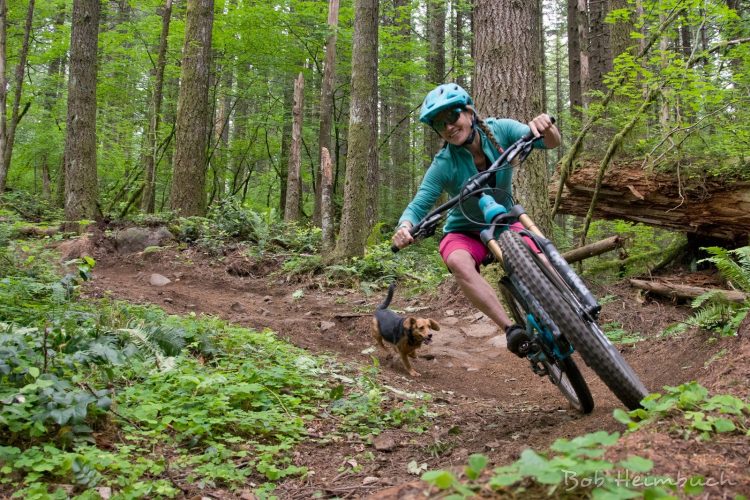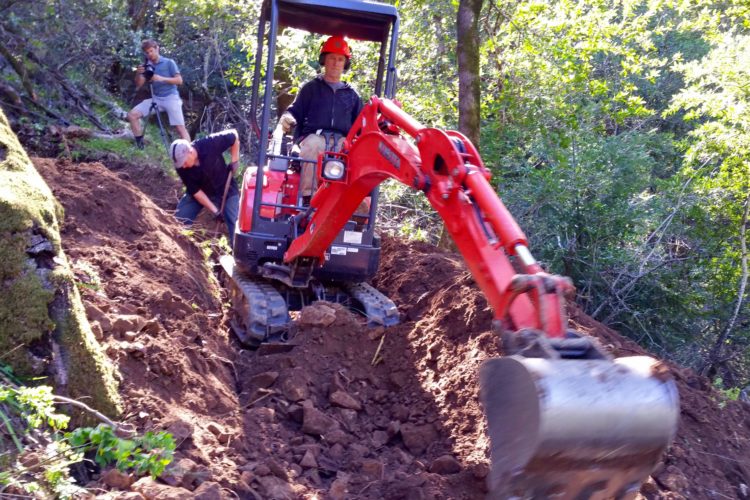
The idea and purpose of a trail have seemingly changed over time, but the aesthetic and the way a trail guides users through terrain has changed even more. Trails have been used to experience nature for ages in various forms of recreation, and as routes for travelers.
Mountain biking has influenced the way a trail is built more than any other form of recreation, and that continues to change because mountain bikes are always evolving. When professional trail builder Tom Lepesqueur was a kid, trail building meant sketchy features, like wooden jumps with bad landings, or teeter-totters that landed on other teeter-totters. They didn’t need to look good or flow together. The trails they built in random places throughout New England forests kept Tom and his brother busy as children, and made for fun, yet sometimes dumb, challenges.
“We’d push each other into doing foolish things. And, building really crazy stuff, especially for how bad our bikes were,” says Lepesqueur. “We broke a lot of bikes.” Lepesqueur and his brother rode Huffys and other BMX bikes around, “farm-fixing” them when they broke and riding them much greater distances than 20″ bikes are designed to be ridden. Lepesqueur describes the days of his childhood as simple and free. On the weekends, he and his brother would “eat breakfast, leave, and come back when it was dark. It was definitely a different time. I think [our parents] were just happy we weren’t bothering them.”
When Lepesqueur made it to college, his interest in mountain biking returned, after a lull in his high school years. He spent weekends building trail illegally or as a volunteer for an organization, escaping from the stress and books of college, which, as a neuroscience student, there was plenty of.

When Highland Mountain in New Hampshire started to build a bike park — something that was still fairly unheard of in the mid-2000s — Lepesqueur doubled down on his volunteer digging and formed a relationship with Mark Hayes, the owner of Highland Mountain Bike Park. Again, he and his brother found themselves out digging in the woods, until dark, day after day. It didn’t matter whether he had nothing to do, or if he had a final exam the next week.
Tom built some of Highland’s first machine built trails and soon enough Hayes offered him a full-time job as a trail digger for the bike park. Lepesqueur’s plan to take a year off after graduating college and then go to graduate school to be a physical therapist faded away, and his love for building trails solidified.
“The thing I love about excavation is that you have a goal that you work toward all day and at the end of the day you can see it. With other types of work, and school, I felt like I was grinding away and never getting anywhere.”
Lepesqueur dialed in his craft over a ten-year period at Highland Mountain Bike Park, building more flow trails and developing the park, and ultimately became the lead trail builder, with a numbered crew. He also spent a month in Virgin, Utah, when Red Bull hired a Highland crew to build massive features for Rampage like the Oakley Sender, before the event scratched unnatural jumps for good.
The job started to wear on Lepesqueur though. He was in charge of too many things, wanted to have more time with his family, and wanted to build in a different style, rather than just the gravity-minded trails at the bike park.

He thought about going back into excavation work, but he started getting more work with his own trailbuilding business in Vermont, which he’d started during his time at Highland. More and more, he wanted to build trails that were designed for the majority of people to ride, with climbs and descents, and public access.
“The way the industry was going was better all-mountain bikes. It just seemed more in line with how I was approaching riding and how other people were approaching riding. Building those types of trails was really appealing to me, and not doing it with 8-10 workers. It was just me and a machine.”
Since then, Lepesqueur’s business, Lepesqueur and Daughters, has turned into a full-time business and as of now, he’s booked for the next two years. He’s built trails in Vermont towns along the Route 100 corridor, in Stowe, Blueberry Lake, Middlebury, Waterbury, Killington, and of course in his home town of Rochester.

Rock work on the trails in Killington 
His process starts when a land manager or trail organization sends him a proposal. If he’s interested — and Lepesqueur is at a point in his career where he has to turn down work — then he will go to the site to look it over before a bid meeting. After a contract is secured, there’s a lot of back and forth between him and land managers. He wants to know what exactly is possible with the new trail, how he can make it the most fun to ride, and how to please the stakeholders. What makes Lepesqueur and the stakeholders happy is maximizing the amount of people that can ride a trail, rather than just a sliver of the mountain biking population.
Every week he gets generous offers from wealthy mountain bikers who want to hire him to build a trail on their property. On one hand, it’s a sign that his reputation is preceding him and his craft of trail building is supreme enough, that the well-to-do want a Lepesqueur trail in their backyard. “Sometimes they’re pretty hard to turn down to be honest,” he says. A lot of builders do this kind of work exclusively, but he wants everyone to be able to ride the trails he digs. Not to mention, they are well built trails and a blast to ride.
“Old Gent’s is a new flow trail that Tom built last summer in Rochester for RASTA/USFS and is one of those trails that you simply want to lap again and again,” says Angus McCusker, the executive director of the Rochester/Randolph Area Sports Trail Alliance (RASTA). McCusker and Lepesqueur have known each other since college and they often work together to get trails built.
McCusker says that he is an easy pick for land managers. Lepesqueur is humble, cooperative, trustworthy, and has a meticulous building process; all things that land managers want when they’re working with mountain bike trail builders. McCusker once worked with a state land manager who was skeptical about using machines to build trails. “We took a quick trip to look at a project that [Tom] recently completed on federal land and just by walking the first few hundred yards, they were floored at how well built the trail [was built] compared to what they are used to seeing.”
Often his building technique involves swapping vegetation and layers of soil from the side, with the top soil of a planned trail, which may seem unnecessary or time consuming, but is said to be more sustainable and more visually appealing.
“Not only does he have an incredible knack for understanding trail flow in all aspects, whether it’s on the ground or with various natural and manmade features, his style of building is extremely efficient and sustainable,” says McCusker. “It almost seems as if someone had placed a ribbon of perfect ‘brown pow’ trail through the forest without any disruptions or impacts to the sides of the trail.”
There’s a vision to this. Getting back to the idea of a trail, historically, they have always served a function, whether it’s allowing for recreation and a way to enjoy the environment surrounding the trail, or to get from point A to point B. As trails, and mountain biking have evolved, so has trail building as an art, where the winding singletrack is as much a part of the beauty as the surrounding water, foliage, and rock. While Lepesqueur might be an excavator, a mountain biker, and an environmental steward, the shape of his trails show a story, and his progress as an artist.
Lepesqueur breaks it down into three parts: The layout, master plan, and the aesthetic. He needs to have an eagle’s eye view in his mind of how the trail will lay over a piece of earth. This is then broken down into sections, which need to be linked together, and it takes an understanding of how a rider’s speed works with the terrain. Some might call it rhythm. The last piece he includes is the visual aspect of the trail. He likes to include rock cairns, rock benches, or flat, patio-style rocks to cross sections of trail where water may run through.

Lepesqueur says he isn’t often asked if trail building is an art and hasn’t given it much thought. But hearing from him and those who know him, there are many similarities between his process and that of any painter, writer, or sculptor.
Artists often look back at a piece they wrote, or a photograph they made five years ago, only to cringe a little bit, as their work has progressed, become more polished, or taken a different direction since then. Occasionally, he’ll get another mountain biker who compliments him on a trail they rode, which Lepesqueur built years ago. He takes the compliments, but is usually self-critical, and reflects on something, like a corner he wishes he’d built differently.
“I’ll never master this craft. Every trail I build, I look back on and say ‘I already don’t like that,’ or ‘I learned something from that.’”

His vision as a trail builder might even be the reason he stays as busy as he does. Eventually, he says he may hire another builder to work under him. Lepesqueur definitely has enough work for someone else, considering how far he is currently booked out. The problem is finding the right person. Someone who can match his quality and attention to detail. Typically, those people already have their own business as established builders. It’d be more akin to a collaboration of greats, rather than a ‘Lepesqueur trail, featuring another builder.’ Not that the easy-going New Englander couldn’t get along with the right person. But, who wants to share their signature after working most of their life to perfect a craft?




















